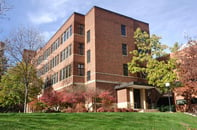Times Will Change, But Standards Will Remain for Community Colleges

The following interview is with Kirk White, director of the Center for Healthcare Professionals at Houston Community College and president-elect for the National Council for Continuing Education and Training. White has a long history in community colleges and, in this interview, he shares his thoughts on how community colleges will evolve over the next half-century and how they will differentiate themselves from four-year universities.
The EvoLLLution (Evo): What are some of the characteristics of today’s traditional community college that separates it from the average four-year university?
Kirk White (KW): I’ve always seen a very distinct difference between a four-year university and a community college, that being that community colleges have a multi-mission purpose.
One is to provide academic coursework for transfer to university but another large piece of it — that is very different from a university — is that workforce training side of things. While a university would produce the degrees needed for professional employment and jobs and that type of thing, the community college really is the on-the-ground trainer for the entry-level technician-type person and some of the entry-level licensure or certification-level positions, anywhere from healthcare — being nursing and allied health, to training emergency medical workers to training manufacturing professionals.
A lot of the workforce — the basic workforce that keeps this country going — is trained at the community college level. And then a lot of those folks do go on to the university level to get advanced degrees to progress … up the career ladder. …
Often times when people want to retool for changing careers, or maybe in our current economy, layoffs still occur, they need to change their careers so they come back to us for bits and pieces to retool their skill set. And they often do that through the non-credit side of the community colleges.
So, in general, there are two very … distinct differences between four-year universities and the community colleges, with the community college being the driver of entry-level workforce training and then professional skills enhancement, down the road, throughout your career.
Evo: Looking 50 years into the future, do you see these traits continuing to define community colleges?
KW: I would hope so. Community colleges are in the realm of public education, as are the public universities in the state. As things go, money drives what we do. Where the funding comes from, or a portion of it, is coming through the state from the legislature and each state decides on what those educational dollars are spent on. So right now if you ask me, 50 years from now, if the funding is still written for the same purpose, I do see us doing the same type of training, both at the university level and at the community college, because they are distinctly different missions and they’re both very much needed.
What I’ve seen over the last few years — and the trend’s across the country of course — is more of a focus on workforce training, rather than academic degree. And there is this push-pull between, “We have to keep producing degrees, bachelor’s level and higher,” and the industry is pushing back, saying, “But what I need today is the skilled worker that may have the certification that proves to me that they know how to do this job. And, great, if they want to go on and get the degree but, right now, this is what we need.”
And I don’t see that trend changing much anytime soon. I think industry is going to continue to push for skilled labor and individuals for their workforce. I think they will look to degrees — higher degrees, bachelor’s and higher from the university level — for their management, supervision and leadership. But I don’t see industry changing a whole lot in what they’re looking for.
If the community colleges continue to do what they’re supposed to do and reflect the needs of their community, then we should be doing the same thing. Now what it looks like, and how we deliver training, what it looks like in the classroom — if it’s even in the classroom anymore — that is probably where the biggest changes are going to happen in the next 50 years: how we deliver education and training.
Evo: One major trend over the past few years has seen community colleges gain the ability to grant bachelor’s degrees. Do you think this trait is going to continue and, if so, how is that going to reshape the role of community colleges 50 years down the line?
KW: Here, in the state of Texas, this has happened a couple of times now. … The Texas Higher Education Coordinating Board went down this road a few years ago and granted the ability to award a bachelor’s degree to, I think, maybe three or four community colleges in the state of Texas. The distinction, however, that remains is the type of bachelor’s that’s awarded and which institutions they allow to award them. In all the cases here, at least in Texas, the award that was allowed is the bachelor’s of applied technology.
So, it’s still a focus, like our associate’s degrees are in workforce, it’s still a focus on applied skills and knowledge to an industry-specific field. It is not a general bachelor’s of arts, it is not a general bachelor’s of science. It’s a bachelor’s of applied technology. So it’s fundamentally — even though it’s a bachelor’s degree — it’s fundamentally a different kind that the universities are not awarding and that were granted for a small set of community colleges. And it’s also predominantly for colleges that are in rural areas within the state of Texas that do not have a university readily available to their community. So, I think those were the two arguments that allowed it to occur. …
The word “competing” between the universities and community colleges, I think there’s a perception — and there probably always will be by certain people in certain areas — that we really do compete. And I think more of the folks that actually work within these institutions understand that we really serve a different purpose. And in those situations when we’re facing the industry, like the nursing [industry] where industry itself is creating a pressure to blur the lines between the university and the community college, I think there’s collaborations that will occur between universities and colleges. I don’t think it will change the nature and purpose at each of the two institutions which, again, as I said before, really stand alone in their purpose and service to the community.
Community colleges, by nature, are designed to be a reflection of what’s needed in the community in which they sit. Therefore, a college in rural, western America is going to have a very different look and purpose and collection of programs than one sitting here in Houston, Texas with an area population of over a million people and multiple industries and international industries. And, so, the community college is designed to respond, to adapt and change to their communities. Universities tend to be more regional, if not on the state level, or attract students nationally, so they’re designed to really provide degree-level programs and awards that work for people no matter where they are, I think, and that are transferable and that really can take somebody to the career beyond the entry-level associate’s degree award.
Evo: Is there anything you’d like to add about the role community colleges will play in the higher education space in 50 years’ time?
KW: I think we will continue to get more and more involved in workforce training and you may see a shift in the community colleges from less of a balance between workforce programs and academic transfer to four-year institutions’ programs. You may see more emphasis put on the workforce. I’m seeing it within my own college; the strategic planning for the next few years is really focused on workforce because that’s what business and industry is pushing for right now.
Again, who knows what will happen with funding. Public funding, even though we are considered a public institution, we have a situation in Houston, Texas where the percentage of public funding continues to drop. So instead of having the 30-30-30 split between student tuition, tax dollars coming from our service area and 30 percent coming from state dollars, we’re slowly losing that third leg of the stool from the state, which will have an impact on what community colleges can do in the way of funding and facilities as we move forward in the future and as we become more like a university — funding wise — where we’re relying more heavily on two sources of income. [Universities] rely on state and tuition; we rely on state, tuition and taxes. If we’re losing our state hold on the money, then we’re going to rely on tuition and taxes. What does that mean in the way of how fast we can grow, how fast we can respond to new and emerging technologies and all of that?
It’s hard to tell; 50 years is a long way out. I do know that we are going to have to figure out how better to deliver education. … Our adaptation to what technology is out there, the social media, the different methods of teaching students other than sitting them in a classroom physically on our campus, that’s got to evolve faster, because our student base is already there and a lot of the private sector in higher education is already figuring a lot of that out too.
Our public institutions, both universities and community colleges, need to figure out how to evolve faster in that respect. The buildings are, one, the students don’t expect to come to class anymore and sit in a classroom. They want to do it off their PDA or their phone or iPad or whatever or, at minimum, distance learning. And, two, with the funding as it is, buildings are expensive to build, and we’re all struggling with capacity issues with our buildings already. So, how do we expand our reach and serve more people without trying to build more buildings that cost more that students of today really don’t want to spend a lot of time sitting in.
Author Perspective: Administrator



